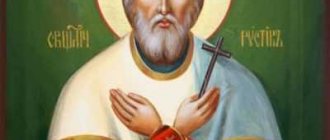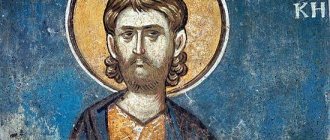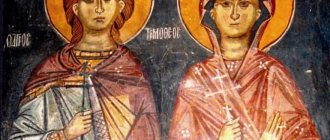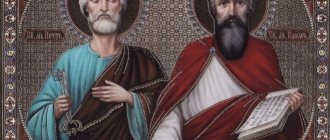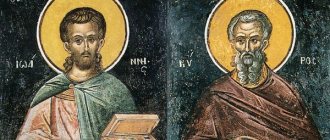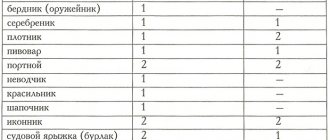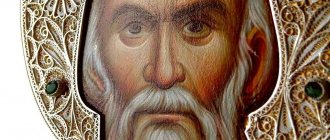Life of Saint James Zebedee
Jacob, like his younger brother John, was an extraordinary, decisive person. But, unlike his brother, he was not destined to live a long life.
Origin
The birthplace of the future disciple of Christ was Galilee. His father Zebedee fished on Lake Gennesaret. Information about the mother has not been preserved. We only know that her name was Salome. Jacob followed in his father's footsteps, earning food for his family by fishing.
Appeal to God
Jesus Christ first saw James and his brother John on the river while mending nets. Called by Jesus, both brothers left their father and workers, ready to follow Him everywhere.
The brothers had impetuous dispositions and hot temperaments, for which they were nicknamed Christos “Boanerges,” which meant “Sons of Thunder.”
The ardent character of the brothers can be judged by the episode with the Samaritans who refused to receive Christ. Angry, John and James suggested that Jesus send heavenly fire rain down on the villagers. And only the prohibition of the merciful Lord Jesus Christ stopped them.
The same thing is observed during the request of Jacob Zebedee and his brother to be given places of honor near the Lord. But Jesus was not angry with the brothers. The Lord used the spiritual impulses of rash and naive disciples for mentoring purposes.
Christ's special attitude towards James is expressed in the fact that the apostle was promised to give him to drink from the cup intended for Himself.
James, like his brother John and the Apostle Peter, witnessed many Divine acts and mysteries of the Savior:
- unusual catch of fish;
- bringing Jairus's dead daughter back to life;
- healing of the mother-in-law of Peter, the first disciple of Jesus.
James was one of the three taken to Mount Tabor to discover the secret of the Transfiguration of Jesus. The holy apostle was next to the Savior during prayer in the Garden of Gethsemane until He was taken into custody by order of the scribes and high priests.
Preaching activities
After the crucifixion of Jesus Christ, His resurrection and ascension, the Holy Spirit descended on the apostles. Each disciple was assigned a country for preaching. Jacob fell to Spain, where he went to preach the word of God.
The apostle had not only an obstinate character, but also fearlessness. So he returned to Jerusalem, openly proclaiming the truth about Jesus as the Savior of the world.
The Jews, powerless against the word of Jacob, hired the learned sorcerer Hermogenes, instructing him to disgrace the saint. But Hermogenes not only could not resist the spirit-bearing man, but he himself accepted the faith of Christ.
Crowds of people gathered around Jacob during his sermons. His words touched the souls of many people, after which they accepted the new faith, secretly being baptized. Thanks to the missionary work of the saint, many Christian communities were created.
Demise
In the year 44 (according to some sources - in 42) from the Nativity of Christ, the earthly life of Jacob Zebedee was interrupted.
According to Holy Tradition, the Jews, who hated Jacob for his preaching activities, complained about the saint to King Herod, demanding a trial of the apostle.
Captured by order of King Jacob, he was thrown into prison and tortured, forcing him to renounce his faith. But the saint remained faithful to his Teacher, continuing to testify to His great mission even after the verdict.
One of those who denounced Jacob, named Josiah, amazed by the apostle’s courage, believed his words about Christ - the Messiah, sent by the Lord. Having believed in Christ, he began to pray to Jacob for forgiveness, repenting of his sins.
For the popular recognition of faith in Christ, Josiah was sentenced to death along with the holy apostle. Both men sentenced to death were beheaded.
From the beginning VI century images of I. Z. are marked by stable portrait features: he is a medieval man with a black beard and mustache (in the scene “Communion of the Apostles” on a miniature from the Rossano Gospel, 6th century - Cathedral Museum, Rossano, Fol. 4r, and on a silver platter 578 g .). The main iconographic types of images of I.Z., developed before the 6th century. inclusive, are associated with the events of his life described in the Gospels (Matthew 4.21; 27.56; Luke 9.54; Mark 3.17; 10.35-41).
In early monuments, I. Z. is shown as one of the 12 chosen disciples in the presence of Jesus Christ (in accordance with the indications of most apostolic lists, he most often occupies a place close to the Savior) or as a witness to the events of His life, for example. resurrection of Jairus's daughter, Transfiguration, prayer for the cup (in the mosaics “Multiplying of the Loaves”, “Prayer for the Cup”, “Kiss of Judas” of the central nave of the Church of Sant’Apollinare Nuovo, Ravenna (c. 526); in the composition “Transfiguration” in the concha the central apse of the catholicon of the monastery of the Martyr Catherine in Sinai (550-565); in the “Ascension” scene in the apses of the chapels XVII, XLII in the Bauite monastery (VI - early 7th centuries) and on the reverse side of ampoule No. 10 from Monza) , and also as a participant in the events described in the Acts of St. the apostles (in the scene “The Election of the Apostle Matthew” (Acts 1. 15-26), on the miniature of the Gospel of Rabbi Rabbula - Laurent. Plut. I.56. Fol. 1r, 586).
In the monuments of the 1st group there are images of I. Z., represented bust-length in a medallion (imago clipeata): for example, on the vaults of the apse in the Archbishop's Chapel in Ravenna (494-519); in c. San Vitale in Ravenna (546-547); on a woven icon from the VMC monastery. Catherine in Sinai; on the reverse side of ampoule No. 3 from Monza (VI century); and also in full height among the 12 disciples in the presence of Jesus Christ (Collegium Apostolorum): frieze over the triumphal arch in the cathedral church. in the name of St. Euphrasian in Porec, Croatia (543-553).
Together with his brother, ap. John the Theologian, I. Z. was depicted in the illuminated Psalms as a young man in white robes, for example. on the marginal miniatures of the Khludov Psalter (GIM. Khlud. 129. L. 75 vol., mid-9th century), where the verses of Ps 76 are illustrated with the image of the Baptism of the Lord, personifications of 2 rivers and images of 2 young apostles, apparently as the embodiment of the chosen sons of Jacob and Joseph, and also, perhaps, in connection with the nickname of the brother-apostles “children of thunder.” Single images of I. Z. are found in monumental painting: in mosaics and frescoes of the Hosios Loukas Catholicon (30-40s of the 11th century), where he is depicted twice in a medallion - on the arch of the narthex and on the vault of the crypt. The life-size image of I.Z. was included in the post-Byzantine decorations. temples (paintings in the naos of the catholikon of the Dionysiatus monastery on Athos, 1547). In icon painting, single images of I. Z. are extremely rare. Such unique examples include the icon from the monastery. John the Evangelist on Patmos (13th century), which shows a half-figure of I. Z. - a medieval man with dark short hair and a short forked beard; he is dressed in a blue chiton and a bright pink himation with skillfully drawn folds. With the palm of his right hand he touches the rolled scroll, which he holds with his covered left hand. I.Z.’s gaze is fixed on the person praying. In the upper left corner in the heavenly segment there is a half-figure of Christ blessing the apostle. The nobility and severity of I. Z.’s image is emphasized by turning to the classical repertoire, where the apostle is depicted like a statue of an ancient philosopher. These features bring the icon closer to the best works of Byzantium. art (paintings of the Holy Trinity Church in Sopočani, ca. 1265). The appearance of the icon is probably connected not only with interest in the apostolic theme, but also with the veneration of I.Z. as the brother of the saint, to whom the monastery is dedicated.
The image of the apostle is included in the iconography of most evangelical events, which have become an integral part of the decor of Orthodox churches. churches both in monumental decoration and in iconography: “Transfiguration”, “Ascension”, “Blessing for the Sermon”, scenes from the Passion Cycle (“Washing of the Feet”, “Last Supper”, “Prayer of the Cup”, “Betrayal of Judas”, "The Assurance of Thomas"), scenes of apostolic ministry.
The image of I.Z. is present in the “Eucharist” scene in the mosaics of the Cathedral in St. Sophia (40s of the 11th century; identification is difficult) and St. Michael’s Golden-Domed Monastery in Kiev (1008-1118; on the left side of the composition next to St. Bartholomew). In this composition, traditionally for ancient Russian. There is no iconography placed at the top of the royal doors, nor a stable arrangement of the figures of the apostles.
Sometimes the image of I.Z. is found in images of the “Resurrection - Descent into Hell,” as, for example, on the fresco of the parekklision of the monastery of Chora (Kakhriye-jami) in K-pol (c. 1316-1321). In the scene "Transfiguration" into Byzantium. traditions of the X-XII centuries, both in monumental painting and in icon painting and book miniatures, I. Z. is depicted falling on one knee, often to the right of the ap. John (on the miniature of the Khludov Psalter - GIM. Khlud. 129. L. 88 volume, mid-9th century; on the miniature of the Gospel from the Iveron Monastery - Ath. Iver. 1. Fol. 296v, 11th century; on the epistyle 2nd half of the 12th century from the Monastery of Catherine the Great on Sinai - I. W. on the left). In early monuments, the apostle does not cover his face with his hands: fresco of the Cappadocian Tokala-kilise (1) in Goreme, 10th century; composition “Transfiguration” on the icon “Deesis and Feasts” (2nd half of the 11th century, monastery of the Great Martyr Catherine on Sinai); icon from the Xenophon monastery on Mount Athos (late 12th century, see: Qhsauroi tou Agiou Orouj. Qessalonikh, 1997. S. 63); fresco in c. St. Nikolai Kasnitsis in Kastoria, last. third of the 12th century In the emotional, expressive works of the Paleologian time, when the apostles in this composition seem to “scatter” in fear in different directions, I. Z.’s face is often slightly covered with his hand. Such a gesture by I.Z. is also found in Russian. art (for example, the “Transfiguration” icon from the Annunciation Cathedral of the Moscow Kremlin at the beginning of the 15th century, GMMK). In some Russian monuments of the XIV-XVI centuries. I.Z. is depicted tightly covering his face with his palms, as in the Novgorod icon from c. Dormition on Volotovo Field (3rd quarter of the 15th century, NGOMZ) and on the Vladimir icon, 2nd half. XVI century (GVSMZ). At the turn of the 16th and 17th centuries. the apostle was again depicted with an open face, and the inscription “Apostle James” appeared near his figure, as, for example, on the icon of Nazarius Istomin Savin from the Chudov Monastery (1626-1628, GMMC). Still in the art of the Middle Byzantine. time "Transfiguration" was sometimes illustrated several times. scenes. Thus, in the parchment Gospel of the 12th century. from the Athonite monastery of the Great Martyr. Panteleimon (Ath. Pantel. 2) 2 miniatures depict Jesus Christ leading the apostles Peter, John and I. Z. to Mount Tabor (Fol. 252), and the appearance of Christ on the mountain (Fol. 252v). The figures of the apostles have a different scale in each scene; they also differ in the color of their clothes, for example. I.Z. is dressed in a light blue chiton and a white-pink himation; in the theophany scene his chiton is blue and his himation is lilac. Since the 14th century The iconography of the “Transfiguration” with the figures of Christ and the apostles ascending and descending from Mount Tabor became widespread, as, for example, in the paintings of c. The Virgin Mary Perivelept in Mystras (3rd quarter of the 14th century), on the temple icon from the Transfiguration Cathedral of Pereslavl-Zalessky (beginning of the 15th century, Tretyakov Gallery), on the icon of the 2nd quarter. XV century from the collection of M.E. Elizavetin and others. In late Russian. iconography, in addition to the ascent to Tabor, there are images of the apostles until the moment of the Transfiguration (icon of the mid-17th century from the collection of K.V. Voronin, see: Smirnova E.S. Newly discovered Novgorod icon of the 2nd quarter of the 15th century in a private collection and question about Old Testament motifs in the iconography of the Transfiguration // Ikhm, Issue 10, pp. 290-306).
The iconography of the “Ascension”, which developed in early Christ. period (Gospel of Rabbi - Laurent. Plut. I.56. Fol. 1r, 586), was in demand in the decoration of the altar vault, as in Cappadocian temples (Tokali-kilise (2) in Goreme, late 10th century, “ Great Dovecote" in Çavuşin, between 963 and 969), as well as in the domes of some domed basilicas and cross-domed churches. One of the earliest surviving monuments is the mosaics of the dome of St. Sophia in Thessalonica (c. 885), where the image of I. Z. follows the images of the apostles Philip and Simon. A similar sequence is also typical for Russian. monuments of the 12th century: frescoes of the Transfiguration Cathedral of the Mirozh Monastery in Pskov (30-40s of the 12th century), St. George's Church. in St. Ladoga (60-70s of the 12th century), the Transfiguration Cathedral of the Euphrosyne Monastery in Polotsk (60s of the 12th century). The mosaic figure of I.Z. was located in the pier of the drum of St. Sophia of Kyiv (40s of the 11th century, in the place of the lost mosaic, late oil painting is now in place).
As with most other holiday icons, in the iconography of “The Dormition of the Most Holy. The Mother of God and the apostles were depicted without halos and without inscription of names. I.Z., as a rule, is in the left group of the apostles, together with the apostle. Peter, the exception is the compositions of the so-called. cloudy Assumption, where the apostles flying on the clouds are depicted with halos and inscribed (“Assumption of the Blessed Virgin Mary” from the Tithe Monastery in Novgorod, early 13th century, Tretyakov Gallery). From the end XVI century signatures of the names of the apostles are found consistently: 2 icons from the collection of K.V. Voronin, one - con. XVI century, where I. Z. is depicted to the right of the bed of the Mother of God, and others - the last. third of the 18th century, where I.Z. together with the ap. Peter are depicted in the foreground (see: Six centuries of Russian icons: New discoveries: Excerpt from private collections for the 60th anniversary of the Central Museum of Art and Arts. M., 2007. Cat. 13, 18).
Sometimes I.Z., among the 12 apostles, is present on the icons “Protection of the Most Holy. Mother of God”, as, for example, on the icon from c. Nativity of St. John the Baptist Dionysius of Glushitsky Sosnovets Monastery (1st quarter of the 16th century, VGIAHMZ).
I. Z. is depicted in the composition “The Descent of the Holy Spirit on the Apostles”, the iconography of which, according to A. Grabar, developed in the post-conoclastic period in the 9th century. The earliest surviving ones are miniatures from the Codex of Gregory of Nazianzus from 867/86. (Paris. gr. 510. Fol. 301v), Khludovskaya Psalter (GIM. Greek. 129 d. L. 62, mid-9th century). The plot is often found in manuscripts, e.g. in Homilies (Words) of Gregory the Theologian, 3rd quarter. XI century (GIM. Sin. Greek. 161. L. 29 vol.), as well as in Byzantium. icon painting and as part of the monumental decoration of churches. According to Rev. N. Ozolina, mosaic image of Pentecost 9th-10th centuries. located in the east. dome south gallery of the Cathedral of St. Sophia in K-pol (Ozolin N., Archpriest. Orthodox iconography of Pentecost: On the origins and evolution of the Byzantine edition. M., 2001. P. 155). The dome compositions “The Descent of the Holy Spirit on the Apostles” were preserved in the mosaics of the Catholicon of the Hosios Loukas monastery (30-40s of the 11th century), and the Cathedral of San Marco in Venice (12th - early 13th centuries). The plot is present in the fresco painting of the transept of St. Sophia of Kyiv (40s of the 11th century). Since the 14th century the image of Pentecost spread in icon painting as part of festive rows and as temple images: icons from the festive row of St. Sophia Cathedral in Novgorod (c. 1341, NGOMZ) and the Annunciation Cathedral of the Moscow Kremlin (c. 1405, GMMK); temple icon from the Holy Spirit Monastery in Novgorod (2nd third of the 15th century, NGOMZ), the cut contains remains of initials near the halos - I.Z. is depicted in the middle of the right group of apostles.
In scenes of apostolic service, the image of I. Z. is presented: on the fresco “Sermon of the Ap. Jacob" from the cycle of the Acts of the Apostles in the Transfiguration Cathedral of the Mirozh Monastery in Pskov, 30-40s. XII century; in the painting c. Vmch. George in Staro-Nagorichino, 1317-1318 - martyrdom.
The image of I.Z. is present in the iconography of the “Cathedral of the 12 Apostles”, which is not widely used, for example. to Byzantium. icons: from the collection of A. N. Muravyov, acquired from the Pantocrator Monastery on Mount Athos (beginning of the 14th century, Pushkin Museum); OK. 1330 (see: Byzantium at Princeton: Byzantine Art and Archeology at Princeton University: Catalog of an Exhibition at Firestone Library. Princeton, 1986); con. XV century (cm.: ?????????? ?., ????????-????????? ?. ????????????? ????????? ??? ?????????? ??????? // ???????????? ??? ???????? ???????????????????.???????????, 1982. ?. 22. ???. 5a, 6). Images of the apostles on the icon of the beginning. XIV century (Pushkin Museum) are identified in different ways. The inscription mentions both apostles - I.Z. and Jacob Alfeev. The letters “IA” on the halo of the apostle depicted in the foreground on the left, whose face is partially lost, are an indication of the elder James, as is the place of honor next to the chief apostles. In Russian art, the earliest image of this iconography comes from c. The Twelve Apostles on Propastekh in Novgorod (c. 1432, NGOMZ), where I. Z. is depicted on the left in the top row, between the apostles Thomas and Andrew. On the temple icon from the Novgorod Holy Spirit Monastery (1st quarter of the 15th century, NGOMZ) I. Z. sits on the right, after the apostles Paul, John and Matthew.
In con. XV century in Russian In art, a variant of the excerpt “The Council of the 12 Apostles” became widespread - “The apostles are bound by a union of love”, the literary basis of which was the texts of the service to the holy apostles. In the upper part of this composition there is a 3-figure Deesis in flowering branches; below, branches extend from the tree of the Savior’s genealogy, forming space for the half-figures of the apostles. According to researchers, the origins of this iconography go back to the “Tree of Jesse” iconography. The earliest surviving monument is the Sophia tablet “Nativity of St. John the Baptist. Cathedral of the Apostles" (late 15th century, Tretyakov Gallery), where opposite the ap. Andrei is depicted as I.Z. with a small beard and holding a scroll in his hands. A similar composition is known: on an embroidered shroud from the Resurrection Cathedral in Volokolamsk (1510, Russian Museum); as part of the annual Menaion (mid-3rd quarter of the 16th century, Icon Museum, Recklinghausen); on a tablet (XVI century, Tretyakov Gallery); in the painting of the Annunciation Cathedral of the Moscow Kremlin (1547-1551).
In sewing, this plot was used to decorate the sakkos of Patriarch Nikon in 1655, on which generational figures of the apostles are embroidered in round stamps, the number of apostles is increased; I.Z. is depicted in prayer.
The tradition of depicting the apostles on stoles (among whom I.Z. is present) is associated with the theme of apostolic service and, probably, iconographically dates back to both Greek and Russian. practice - to the composition “Cathedral of the 12 Apostles”: on the epitrachelion of Archbishop. Galaktiona con. XVI century from the Iveron Monastery, on which the apostles are presented full-length framed by arches; Epitrachelion of Patriarch Nikon 1652-1658, the apostles are also depicted full-length (GMMC).
In sewing, images of the apostles were placed on the borders of shrouds and shrouds. On the shroud "Assumption of the Most Holy" Mother of God" from the Kirillov Belozersky Monastery (15th century, Russian Museum) I.Z., in addition to the centerpiece, is depicted in a medallion on the border; on the shroud “Entombment”, a gift from Tsar Alexei Mikhailovich to the Novospassky Monastery (1645-1647, GMMK), the half-figure of I. Z. is depicted behind the apostle. Andrei on the lower border, on the upper border of the shroud “Entombment” from the Chudov Monastery (1678, GMMK) and on the lower border of the shroud “Entombment”, inserted by Rev. Matthew to the Solovetsky Monastery (1704, GMMK). In the sacristy of the Iveron Monastery there are orders from 1681 with the image of the Eucharist and the Last Supper, at which 6 apostles are present, among them I.Z.
The figure of I. Z. is part of the group that spread throughout Rus' from the 17th century. so-called apostolic ranks, when in the Deesis series after 7 traditions. icons of the 12 apostles were placed in the images. The image of I.Z. could be either on the left or on the right side of the row; The apostle's clothes vary in color. Among the famous examples: the deesis row of the Assumption Cathedral of the Moscow Kremlin (1653), the icon of Tikhon Filatiev of 1691 from the deesis of the Moscow c. Nativity of the Most Holy The Virgin Mary in Golutvin (Tretyakov Gallery), icon of the 1st quarter. XVIII century from the Deesis (apostolic) row in the Spaso-Preobrazhenskaya Church. in Kizhi; con icon XVIII century from the iconostasis of the church in the village. Selezenikha Novotorzhsky district. Tver lips. (see: Krasilin. 1996. P. 90. Ill. 12). In modern times, images of the apostles in iconostases were sometimes grouped into several groups. figures, as, for example, on the icons of con. XVII century “Apostles Peter, Andrew, John, James, Bartholomew and Thomas” from c. Intercession in Fili (CMiAR) and “Six Apostles: Matthew, James, John the Theologian, Thomas, Mark, Peter” (late 18th century, State Museum of Palekh Art). There are life-size images of the apostle in prayer, possibly included in the Deesis rites, as on the Old Believer icon “Apostles Simon the Zealot and Jacob Zebedee” from the collection. A. A. Kirikova (2nd half of the 19th century, see: Syzran Icon. Samara, 2007. Cat. 57). Similar apostolic ranks were also known in Byzantium. art, for example apostolic rank with half-length images from c. St. Blasius in Verria (1360, Museum of Byzantine Art, Verria), and in Greek. traditions of the New Age, for example. half-length depiction of I. Z. on the icon c. 1700 (Icon Museum, Recklinghausen). In Balkan art of the 18th-19th centuries. individual icons of I.Z., not part of the apostolic rank, are also included in the iconostasis, such as, for example, the icon in the iconostasis of the parekklision of the Great Martyr. Demetrius 1813-1814 in the Decani monastery (see: Manastir Decani. Beograd, 2005. P. 88).
In the 17th century an iconography of the apostolic sermons and passions was developed, based on the texts of canonical and apocryphal acts: the icon “Apostolic Sermon” from c. prophet Elijah in Yaroslavl (1660-1662, YaIAMZ), “Savior Pantocrator, with the Apostolic Passion” (1652, Church of the Resurrection on Debra, Kostroma; see: Kostroma Icon. 2004. Cat. No. 77), “Apostolic Sermons and Passions” from the Procopius Cathedral in Vel. Ustyug (1668, VUIAKHMZ), Pskov icon “Apostolic Sermons and Passion” con. XVII century from the collection of K.V. Voronin, “The Crucifixion with the Apostolic Passion,” written by Fyodor Rozhnov commissioned by Patriarch Adrian for the Assumption Cathedral of the Moscow Kremlin (1700, GMMK). These icons depict the preaching of the Gospel and the beheading of I. Z. In connection with the development of the apostolic theme in the art of the 17th century. scenes of the apostolic passion and images of the apostles are often included in programs for painting churches, for example. c. ap. John the Theologian in Rostov (1683), where I. Z. is depicted full-length in the slope of the window, the plot is “The Beheading of the Apostle. Jacob" is placed on the gallery of the temple. The composition “The Calling of the Apostles John and James” is presented in the south. wall c. prophet Elijah in Yaroslavl, and the image of I.Z. is on the vaults of this temple (1680).
In icon painting, images of the 12 apostles were common, among whom was I.Z., on the margins of icons with different subjects in the middle: “Savior Almighty, with the Apostles” (late 14th - early 15th centuries, Tretyakov Gallery) - on the left field half-figure I. Z. with a scroll in his hand; “The Crucifixion, with the Apostles” (XIV century, State Russian Museum), Balkan icon “Deesis with Etymasia and Saints in the Fields” (late XIV-XV centuries, Tretyakov Gallery) - I. Z. in a medallion; “Christ on the throne, with the apostles” by master Longin (1590, sacristy of the Decani monastery) - full-length, on the field of the icon “St. Nicholas the Wonderworker” by master Alexa Petrov (1294, NGOMZ). Particularly important is O, which is a kind of prototype of Russian. “Apostolic” Deesis (2nd half of the 11th century, monastery of the Great Church of Catherine on Sinai) - after the 7-figure Deesis there are 12 apostles in pairs.
The image of I. Z. is presented among the images of the apostles and martyrs on the margins of the icon “Our Lady of Jerusalem (Gethsemane)” (Assumption Cathedral, GMMC, 18th century) and its copies, for example. from the Cathedral of the Nativity in Izmailovo (Moscow) (Tolstaya T.V. Icon “Our Lady of Jerusalem (Gethsemane) from the Assumption Cathedral of the Moscow Kremlin and her legend // Byzantine World: The Art of Constantinople and National Traditions. M., 2005. P. 647 -662; Komashko N.I. Icons “Our Lady of Jerusalem (Gethsemane) letters of Kirill Ulanov // Ibid. pp. 663-668).
I. Z. is represented among selected saints, as, for example, on a 3-leaf folding panel with images of “Our Lady of the Burning Bush” and “Burial of the Grand Martyr. Catherine" in the middle and saints on the doors (XVI century, monastery of the Great Church of Catherine on Sinai) - I. Z. with a staff in his hand below on the left door (see: Holy Image, Hallowed Ground: Icons from Sinai / Ed .: RS Nelson, KM Collins; The JP Getty Museum. Los Ang., 2006. Cat. No. 58).
In the compositions “The Last Judgment” in icon painting and in monumental painting, I. Z. is depicted seated together with the other apostles on the sides of Christ the Judge. The names of the apostles or the initial letters of their names are written on the sheets of open books, as on the Sinai icon (2nd half of the 12th century, monastery of the Great Martyr Catherine in Sinai). Often I. Z. is presented next to ap. Andrei (fresco of the Dmitrievsky Cathedral in Vladimir, late 12th century). I. Z.’s gestures can be different: a raised hand in a prophetic, pointing or blessing gesture.
In the menaions, images of I. Z. are placed under April 30: in the Greco-cargo. manuscripts (XV century), on menain icons (mid-3rd quarter of the 16th century, Icon Museum, Recklinghausen; late 16th century, KGOIAMZ), etc.
The revered icon of I. Z. (beginning of the 20th century?), in which the apostle is depicted full-length with the Gospel in his hands, is located in the c. Kazan Icon of the Most Holy. Mother of God in the Kazennaya Sloboda in Moscow, where the chapel was consecrated in the name of I.Z.
Lit.: K?nstle K. Ikonographie der Heiligen. Freiburg i. Br., 1926. S. 316, 326; The Saints: A Concise Biographical Dictionary. NY, 1958; Reau. Iconography. Vol. 3/2. P. 69, 74; LCI. Bd. 7. Sp. 23-39; Byzantium at Princeton: Byzantine Art and Archeology at Princeton University: Catalog of an Exhibition at Firestone Library. Princeton, 1986; Endoltseva E. Yu. Formation of the iconography of St. Apostles John and James Zebedee // BT. 2005. T. 40. pp. 148-165.
Lit.: Antonova, Mneva. T. 1. Cat. 46. P. 183; Weitzmann K., Chatzidakis M., Miatev K., Radoj?ic S. A Treasury of Icons 6th to 17th Cent. from the Sinai Peninsula, Greece, Bulgaria and Yugoslavia. NY, 1966. N 39. R. XXVI-XXVII; ??????? ??? ?????? ??????. ????? ??. ??????????????? ?????????? /?. ??????????, ?. ?. ???????, ?. ??????????-???????, ?. ?. ????. ???????, 1975. ?. 2. ???. 5, 31, 294, 295. ?. 28, 46, 170, 171; Smirnova E. S., Laurina V. K., Gordienko E. A. Painting Vel. Novgorod: XV century. M., 1982. S. 32-40, 50-51, 254, 308, 315; Knyazeva L.P. and others. Iconography of Palekh from the collection. State Museum of Palekh Art. M., 1994. S. 76, 148. Ill. LXV; ???????????? ?. ?. ????????? ?????: ?????????? ???????. ???????, 1995. ?. 44, 46; GTG: Cat. collection M., 1995. T. 1. Cat. 10; Krasilin M. M. Iconography and decorative and applied art // Spiritual environment of Russia: Singing books and icons XVII - early. XX century M., 1996. P. 90-113; ??????????-????????? ?. ????? ???? ???????: ?????????? ????? ?? ?????. ?????? ?????. 1998.?. 56, 104; Komashko N.I., Merzlyutina N.A. Church of the Intercession in Fili. M., 2003. P. 60; Kostroma icon of the XIII-XIX centuries. / Author: N. I. Komashko, S. S. Katkova. M., 2004. Cat. No. 27, 77; Mayasova N. A. Old Russian. face sewing. Cat. M., 2004. Cat. 98, 110, 129, 151; Benchev I.Z. Icons of St. patrons. M., 2007. P. 6-7; Vzdornov G. I. Icons-tablets Vel. Novgorod: Sophia Saints. M., 2007. Table. XXI; Icons of Vologda XIV-XVI centuries. M., 2007. P. 196; Syzran icon. Samara, 2007. Cat. 57; Icons Vel. Novgorod XI - beginning. XVI century M., 2008. P. 36; Haustein-Bern E., Benchev I.Z. Museum of Icons in Recklinghausen. M., 2008. P. 243.
E. M. Saenkova
Veneration of the Holy Apostle in Orthodoxy
According to one version, King Herod Agrippa ordered the remains of the apostle to be placed at the bottom of a boat, sailing it across the Mediterranean Sea. An unknown force washed the boat onto the Spanish coast, where the saint was preaching. The boat with the remains of the apostle washed up on the coast lay there for several centuries.
There is also a legend that two of the saint’s disciples, having taken his body, sailed in a boat across the sea to find a place to bury the remains of Jacob. A few days later they reached the shores of Spain and landed on the territory of the Celtic city of Iria Flavia. There they turned to a certain Atiya, a noble woman, with a request to bury the teacher on her land.
The woman reported them to the local ruler, who professed paganism. Christians were imprisoned, but, by the will of the Lord, who sent an angel to help them, they came out of captivity.
This miraculous event so amazed the king and his entourage that they believed in Christ and provided the tomb of Atia for the burial of the saint. Both students were later buried next to their teacher. Gradually, the area around the tomb became empty and overgrown with forest, hiding the holy tomb for a long time.
In 813, the tomb with the incorruptible remains of Saint James was discovered by the hermit monk Pelayo, who lived nearby. The monk found the way to the tomb thanks to a vision. The guiding star showed Pelayo the way to the holy remains. Having discovered the holy place, the monk hurried to Iria to notify Bishop Theodomir about the sacred find.
This served as the beginning of the veneration of the holy apostle. The area where the relics of James Zebedee were found was called Compostella, which meant “place marked with a star.”
In 896, by order of King Alfonso III, construction of a small church began on the site of the ark. Gradually, the area became increasingly populated, and the small village grew into the city of Santiago de Compostela. In 1075, a cathedral was built here, where the tomb of St. James was transferred.
Thanks to the Spanish sailors, the glory of the holy apostle spread throughout the world. The name “Santiago” was assigned to their cities by the following countries:
- Cuba;
- Dominican Republic;
- Argentina;
- Chile.
Temples dedicated to Jacob Zebedee were built in Jerusalem and Moscow. In Jerusalem, a church was erected on the site of the execution of the apostle, and the head of the saint was buried there. In Moscow, the church is located in Kazennaya Sloboda. It contains particles of the saint’s relics brought from Spain.
The Orthodox Church has set the celebration of St. James Day on May 13 and July 13 according to the new style (April 30 and June 30 according to the old calendar). The Catholic Church venerates the saint on July 25. When the celebration falls on a Sunday in Spain, ceremonial events dedicated to St. James take place throughout the year.
Martyrdom
On the day of Pentecost, Jacob, along with other disciples, was filled with the Holy Spirit and participated in the establishment of the first Christian communities. Almost all the apostles remained for some time in Jerusalem, gaining strength and wisdom. But Jacob, by his nature, could not wait. He went to Spain “to the ends of the earth” to preach the Gospel, and then returned to Jerusalem. He boldly and openly preached among the Jews that Jesus Christ is the true Messiah, the Savior of the world. He defeated experienced scribes and Pharisees in disputes; no one could resist the pressure and eloquence of the disciple of Christ.
Church of the Apostle James Zebedee in Moscow in Yakovoapostolsky Lane
Seeing the power of miracles and the teachings of the Apostle James and the complete failure of their plans, the Jews were able to convince King Herod Agrippa I, who then owned all of Judea, to begin a persecution of the Christian Church. The Acts of the Apostles says: “At that time King Herod lifted up his hands against some of the church to do them harm, and killed James the brother of John with the sword” (Acts 12:1-2). This happened in Jerusalem in 44. James Zebedee is the only apostle whose death is described on the pages of the New Testament.
Prayer book
On the days of veneration of the apostle, liturgy and prayer services are performed, and a canon glorifying Saint James is performed. The service ends with short prayer readings - troparia. They can be read not only on holidays, but also on other days, asking the saint to save you from troubles.
Troparion
Saint James the Apostle, pray to the Merciful God that He may grant remission of sins to our souls.
Translation: Holy Apostle James, pray to the Merciful God to grant forgiveness of sins to our souls
Troparion
You were the chosen Apostle of Christ and the only begotten brother of the Theologian, O all-validated Jacob, ask for remission of sins from those who sing and grant great mercy to our souls.
Translation: You were the chosen Apostle of Christ and the brother of Christ’s beloved disciple John the Theologian, ask forgiveness of the sins of those who glorify you and great mercy on our souls.
Canon
Song 1
Irmos: Sometimes immerse the miraculous rod of Moses into the chariot of Pharaoh's chariot, striking it in the shape of a cross and dividing the sea, and the fugitive Israel of Israel, saving the pedestrian, singing the song of God.
Through your dreams, like a skilled fisher, raised from the sins of the depths, blessed one, enlighten my soul with radiant radiances and deserve your praise, O theophany of Jacob, memory, disciple, with similar
The Eternal Father, the Self-Significant, the Most Perfect God, having become incarnate, appeared on earth as a Man and a co-worker of grace, O blessed One, and a servant of the Most Wise One, strengthened by His power.
Know the mind of your soul, nobility, God the Seer, and firmness, disciple, and invincible thought, more glorious, make it better to be your servant, proclaiming with your tongue.
Theotokos: Of the Council of the Great, Father, Angel, from the Virgin Mother appeared to the world, the flesh is received, as the disciple is adorned with virtues, and the one who speaks of God, Jacob, shows His words to His vestity yushcha
Song 3
Irmos: Establish the heavens in the beginning with your mind and the earth on the waters; establish me on the rock, O Christ, establish Your commandments, for nothing is holy except You, the only One who loves mankind.
From above, the needy breath of the Comforter kindled, the wisdom of the God-speaker, vetoing the reality of the greatness of the demonstration of the incarnate Word, Whose self-witness was You.
You, like a chosen arrow, with a subtle word, thrust into the hearts of your enemies, tearing apart the souls of those who oppose you, wise one, and captivating, mysteries, this selfishness, Jacob.
The unfiltered quietness of your soul was seen by the Master, and before the title, blessed one, you appeared to Him, O Jacob, and you were His disciple.
We adorn you clearly with your holiness, wisdom, life and luminosity, with your affinity for God, all-blessed, and your accomplice appeared, for you appeared from childhood as a refugee of the Word.
Theotokos: The mental door of the East appeared from above, appearing to those on earth, Virgin: For through you the Word came to us to save everyone from speechlessness, Most Pure One.
Sedalen
Having caught the tongues, the glorious apostle and taught the ends of the earth to bow down to You with the Father and the Spirit, O Christ God, for this sake establish Your Church and send down Your blessing to the faithful, O God not Merciful and Humane.
Theotokos: Wisdom and the Word in Your womb conceived without burning, Mother of God, You gave birth to the world, the Container of the world, and in your arms You bore all the Bearer, the Nourisher of all and the Creator cook. Moreover, I pray to Thee, All-Holy Virgin, and truly glorify Thee to deliver me from my sins, and on the day of Judgment, when I will appear to the imams before the face of my Creator, the Lady of the Pure Virgin, according to Thy Then give me power: you can do all you can, whatever you want, All-Singing.
Song 4
Irmos: You are my fortress, Lord, You are my strength, You are my God, You are my joy, do not leave the bosom of the Father, and visit our poverty. Meanwhile, with the prophet Habakkuk, I call Ti: Glory to Your power, O Lover of mankind.
You were a preacher of Christ, divine to Jacob, you were called, for you soon followed, despising fatherly love and eternally betraying the current; Thus you have been honored with the indescribable heavenly inheritance, O blessed one of everlasting memory.
Oh, your warm desire for the Lord Christ! For You have greatly desired This, You have been enlightened by His radiance, as if you had imagined, and the second light will appear to everyone, first illuminated by the dawn and glory, most blessed is Jacob.
You lived an honest and wonderful life, with desire, for desire is uncontrollably accepted, you achieved the desires of the Godhead of perfect bliss, O God-Seer, with the bodiless belts: to the power of Your word Wow, more humane.
Having given all to yourself to the beckoning of the Master, disciple of the God-spirited One, with virtues you took to the heights and truly divine land, and from there the healing rivers flow, your memory is truly sweet to the great ones.
Theotokos: You are the praise of the faithful, You are the Blessed One, You are the Representative, You are the refuge of Christians, the wall and haven, for You bear prayers to Your Son, All-blameless One, and You save from troubles by faith and those who know You with the love of the Pure Mother of God.
Song 5
Irmos: Thou hast cast me away from Thy presence, O everlasting Light, and the alien darkness of the accursed one has covered me? But turn me, and direct my path to the light of Your commandments, I pray.
New, like Elijah, we are kindled with jealousy, disobedient to your preaching, you wanted to be burned, more glorious, but the Desirer of mercy forbade you, teaching meekness more gracefully.
Having entered, with finite virtue and love for the sake of the best, you desired to hold the throne of the Lord, the wise one, the first to hold, not as if you desired vain glory, but to see Him in the midst. ́.
Transcending the statutes, O Savior, Jacob of mankind, for in Your power, as in a robe, He has clothed Himself, flowing healings and miracles, and enlightening ends with faith.
The cloud of the Word shone, sheathed in glory, upon the mountain of autumn, blessed Jacob, and you were deemed worthy to hear the voice of the Father, making known His Sonship.
Song 6
Irmos: The abyss of sins and transgressions, the storm confuses me and in the depths of needy despair roars me, but Your strong hand is extended to me, like Petrovi, O Ruler! and save.
Streams, as if from a source, constantly pouring out healings and piously flowing enlightenment of teachings, wise, soul, pious love, Jacob, coming, enlightening, most blessed.
The vessel containing the Lord will find you, most blessed, His rich and honest giving, abounding in gifts, even more than the mind of the sacraments, the servant of ever-essential life.
The mortification of us for the sake of the Lord is willing to accept, the dead, the guilt of the true resurrection, like the wisdom of the secret place, blessed, you took the creator, in the night, in the same time you surrendered.
Theotokos: O Virgin Mother of God, who gave birth to the abyss of generosity, save my soul from the sadness of my life and open my spiritual doors to joy, I place my only hope in You.
Kontakion
Hearing the Divine voice, calling you, you despised the love of your father and ran to Christ, Jacob, with your relative, more glorious, with whom you were made worthy to see the Lord Divinely e transformation.
Ikos
Together with your brother in the villages of heaven, who trampled on the holy Hagarites today, walking with foul and unclean feet, with your divine prayers you will marry, and the tormentor of the plot from for the sake of the sins of those who hold us, now grant us liberation: for having gathered together in one, We see the Lord’s Divine Transfiguration.
Song 7
Irmos: The fire of God was ashamed of God’s condescension in Babylon sometimes, for the sake of the youth in the cave, with a joyful foot, like in a flower garden, with a rejoicing girdle: blessed are you, God the Father on Shih.
You drank the cup, as you promised to the Lord Christ; with this baptism you were baptized, O blessed one. To him now call zealously, rejoicing: Blessed be God our father.
With the dawn of the vision of God, you appeared to Jacob. For this reason the Benefactor Christ adorns you with the crown of the Kingdom, and the angels sing: Blessed be God our father.
Behold, fulfill the promises of the Great One, who ascended to Him in the likeness of His sufferings. Standing before Him, now you call, rejoicing: Blessed is God our father.
Theotokos: We preach the duality by nature, but not by face, Mother, from You incarnate. We depict Him in flesh and worship the image of the imagination, Reconciled to You for God’s sake, Pure One.
Song 8
Irmos: By the Sevenfold the furnace of the Chaldean tormentor furiously kindled the godly, but by the best power he saw those who were saved, he cried out to the Creator and Deliverer: children, bless, priests, praise Praise, people, to all ages.
The Abrahamic sentence, you, God-seer, you received, who called you to follow Christ, and you were a holy servant to Him, as the Creator and Deliverer, singing: boys, bless you, priests, Sing, people, exalt to all ages.
Your proclamation appeared louder than the thunder, the noise of the lawful image. For you have thundered Christ more than the whole universe, God, and Creator, and Savior, saying: children, bless, priests, sing, O people, exalt to all ages.
You were surprised, O glorious one, by the torment of your lordship and piety by true enlightenment, for you were installed as an apostle prince throughout the whole earth, to the Creator and Deliverer, saying: young men, bless, sacred Prostrate yourself, sing, people, exalt Christ forever.
Theotokos: The heathens cannot sing to you, O Mother of God, Mary Bride of God! For you gave birth to God, who exists above all, the Pure Maiden, Creator and Savior, to whom we cry: children, bless, priests, sing, O people, exalt to all ages.
Song 9
Irmos: The heavens were terrified at this, and the ends of the earth were amazed, for God had appeared as a man in the flesh, and Your belly was the most spacious of the heavens. Thus, Ty, the Mother of God, the angels and the people of the ranks are magnified.
Your holy life has passed, you have reached the holy villages, where, rejoicing, you saw the dawn of three; Even as they enjoy themselves, wisely, your singers are filled with joy and joy, O most blessed one, show them through your prayers, O Jacob!
Seeing you, the villains and murderers, like your Master before, are not tolerant: for reproaching those for their actions, you have denounced them by the sentence of your life, they are killing with the sword an imitator of Christ crucified by the flesh and for men, O blessed one of God!
Having been tormented by the weapons of heaven, Herod perished with his wounds, for Thy, O Word, the servants and disciples, whom the apostles called thou, the accursed one was not content to kill. Moreover, we magnify you, the righteous providence of the Benefactor.
Theotokos: You appeared, O Virgin, the Mother of God, having given birth to the flesh of God the Word more than by nature, whose Father I will vomit from my heart, before all ages, for He is good, Now we also mean that we have exceeded the body, even if we have put on the body.
